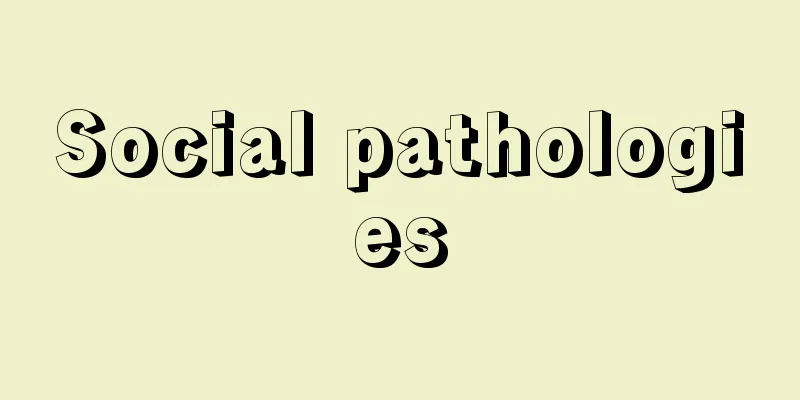Social pathologies

|
It refers to a pathological condition that occurs in society. For example, the term is used to refer to phenomena such as crime, delinquency, suicide, vagrancy, prostitution, corruption, running away from home, alcoholism, drug addiction, and domestic violence. Some people also classify these into individual pathology, group pathology, community pathology, and cultural pathology. The academic field that studies these is called social pathology. [Hiroaki Iwai] The occurrence of pathological phenomenaIf we look at these phenomena in terms of individual cases of behavior, they naturally arise based on the internal conditions of the individual. For example, in the case of crime or delinquency, it goes without saying that there is some kind of distortion in the personality of the criminal or delinquent who commits the crime. Suicide, too, is related to the inner instability of the mental structure of the person who commits it. However, the problem with these acts is that they are not simply individual, but are common and characteristic to a certain extent to a large extent in society. In other words, when viewed as a broad, collective social phenomenon, the roots of their origin must be found in society, not just in individual causes. Pathological phenomena are intricately related to the various dimensions that make up society as a whole, namely, family life, the workplace, the local community, education, and other areas. For example, crime and delinquency cannot be unrelated to the upbringing, upbringing, and emotional life of the perpetrator in the family, and it goes without saying that domestic violence and divorce conflicts are related to the very nature of family life, such as emotional incompatibility and impaired role relationships. In many cases, mental anxiety, alcoholism, suicide, and disappearance occur in relation to the mechanical life of a busy business or the pressure and pain of complex human relationships in the workplace. Slums, drug trafficking, red-light districts, and youth problems are also problems of the local community that are inversely related to the prosperity of cities. Delinquency, school violence, school refusal, and bullying are problems that are deeply related to education as well as family life. Furthermore, pollution and drug-related damage are not simply natural disasters but are essentially man-made disasters, and are the products of a developed industrial society. Generally speaking, the more complex a society is and the more drastic its changes, the more likely these pathological phenomena are to occur. There are economic and interest conflicts, intensifying mutual competition, friction and conflicts of values, and increased mobility and anonymity, which result in significant maladjustment of human relationships and social disintegration. Social development increases the convenience of people's lives, but at the same time, the above-mentioned conditions often put pressure on individuals, creating constant psychological instability and forming the basis for the occurrence of pathological phenomena. In a sense, it can be said that as the wealth of a society increases, so do the problems. Of course, the overall political and economic system is not unrelated to social pathology. Similarly, when it comes to social pathological phenomena, some problems are related to the social system and some are trans-systemic. For example, poverty and slums can be said to be unique to the capitalist system. However, crime, suicide, divorce, etc. are phenomena that are widely seen in both capitalist and socialist countries, regardless of the system. For example, when it comes to suicide, the former socialist countries of Eastern Europe, such as Hungary and the former Czechoslovakia, had even higher rates than capitalist countries such as the United States and the United Kingdom. [Hiroaki Iwai] Judging social pathologyThe term social pathology is originally a term borrowed from medical pathology. Medical pathology is a science that clarifies the true nature of pathology, investigates its causes, and contributes to the treatment and prevention of disease. The concept of social pathology was born from the analogy of society to a biological organism, and the view that just as illness occurs in biological organisms, society also has pathological phenomena that impede its organic activity and smooth functioning. Indeed, in the social life of humans, there are what could be called diseases that weaken organisms, such as the phenomena mentioned above, and it is extremely important to identify their causes and develop measures to treat and prevent them. However, we must also consider that a complex entity such as society is not simple enough to be described by the word "organism," nor can it be a direct replica of a biological organism. In biological organisms, the criteria for determining what is a disease, what state is healthy, and what state should be called a disease are relatively clear. In contrast, in the social life of humans, unlike purely individual diseases, it is quite difficult to accurately determine what is a normal, desirable state and what state should be called a disease. For example, the standards of evaluation are relative and may differ depending on the era, society, and culture. Homosexuality may be considered abnormal in one society, but not in another. It even differs by era. Sexually liberating behavior may be considered unhealthy in one society, but its suppression is considered unhealthy in another society, and liberation is considered a desirable health state. In this way, there is relativity even in a society's response to sex. Furthermore, when it comes to a phenomenon like divorce, it becomes even more complicated. The conflict of divorce certainly brings pain to the couple, but depending on your point of view, it may be considered unhealthy to continue married life without love. Also, divorce may have been considered abnormal in an era when divorce was rare, but when the divorce rate increases, becomes overwhelmingly common, and becomes a fairly common phenomenon, can it really be called a disease? Medical judgment and social judgment are quite different. For example, when a doctor examines a patient, that patient is sick, but if that doctor is extremely commercial or experimental, and thinks of the patient as merely a monetary object or a guinea pig, then the doctor may be judged by society as a sick person who has lost his humanity.More broadly, not only individual pathological phenomena, but also the society that produces them may be judged as a sick society.In short, when judging social pathology, it is not so easy to determine what constitutes a disease, and it is necessary to be fully aware that the standards for evaluation are heavily influenced by values. [Hiroaki Iwai] Investigating social pathologyToday, the view of society based on an organic model and regarding social problems as illnesses is gradually falling into disuse, and instead, terms such as deviance and bias, which are neutral in value judgment, tend to be used. However, even so, in the reality of social life, various acts occur that injure and cause suffering to oneself, or that cause trouble to others and society. Therefore, regardless of the appropriateness of the term, it is extremely important to take up phenomena that are considered problematic by the majority of people in society as common sense, and to carefully analyze and investigate their characteristics, causes of occurrence, and processes. Through such a process, the fundamental question of in what sense something deserves to be called a pathology or not, will naturally become clear. [Hiroaki Iwai] "Social Pathology" edited by Ohashi Kaoru (1966, Yuhikaku)" ▽ "The Structure of Pathological Groups" by Iwai Hiroyuki (1963, Seishin Shobo)" ▽ "Modern Social Illness Theory" by Oyabu Toshikazu (1982, Gensousha)" ▽ "New Social Pathology" edited by Mochizuki Takashi (1984, Gakubunsha)" ▽ "Lectures on Urban Pathology" all 4 volumes edited by Nasu Soichi, Iwai Hiroyuki, Ohashi Kaoru and Oyabu Toshikazu (1973-76, Seishin Shobo)" [References] | | | | | | |Source: Shogakukan Encyclopedia Nipponica About Encyclopedia Nipponica Information | Legend |
|
社会に発生する病的な状態をいう。たとえば、犯罪、非行、自殺、浮浪、売春、汚職、家出、酒精依存、麻薬中毒、家庭内暴力などの現象をさしてこのことばが用いられている。また、人によっては、これらを個人病理、集団病理、地域病理、文化病理などに分類している場合もある。これらを研究する学問を社会病理学social pathologyという。 [岩井弘融] 病理現象の発生これらの現象は、個々の行動の事例に即してみるならば、もちろん、個体の内的条件に基づいて発生している。たとえば、犯罪や非行では、これを行う犯罪者や非行者のパーソナリティーになんらかのゆがみがあることは、いうまでもない。自殺もまた、自殺者の精神構造の内面の不安定にかかわっている。しかし、これらの行為は、単に個別的というばかりでなく、社会にある程度、大量に、かつ共通的、特徴的にみられるところに問題がある。すなわち、広く集合的な社会現象としてみた場合、個体原因ばかりでなく、社会にその発生の根が求められるのである。 病理現象は、全体社会を構成するもろもろの次元、すなわち家族生活、職場、地域社会、教育などの諸領域に複雑にかかわり合っている。たとえば、犯罪や非行は、その行為者の家庭における生い立ちやしつけ、情緒生活と無関係ではありえないし、また、家庭内暴力、離婚葛藤(かっとう)などが感情の不一致、役割関係の阻害などの家族生活のあり方そのものに関連することは、いうまでもない。精神不安や酒精依存、自殺、蒸発などが、忙しいビジネスの機械的生活や、職場での複雑な人間関係の圧迫、苦痛にかかわって発生している場合も数多い。スラム、麻薬売買、売春街、青少年問題などは、都市の繁栄と表裏の関係にある地域社会の問題でもある。非行、校内暴力、登校拒否、いじめなどは、家族生活と同時に、いうまでもなく教育にもっとも深くかかわる問題である。さらに、公害、薬害などは、単に自然的災害というのでなく、本来的に人災であり、発達した産業社会の産物である。 総じて、これらの病理現象は、社会が複雑になり、その変化が激しければ激しいほど生じやすい。そこには経済や利害の衝突、相互の競争の激化、価値観の摩擦や相克、移動や匿名性anonymityの増大があり、その結果、人間関係の不調整、社会の不統合が著しくなっていく。社会の発達は、人々の生活の利便を増すが、同時に、前記のような条件のためにしばしば個人への圧力となり、その不断の心理的な不安定さを生み、病理現象発生の基底を形づくっていくことにもなるのである。ある意味では、社会の豊かさが増すとともに問題もまた増えていく、ともいえよう。もちろん、全体的な政治経済体制も、社会病理と無縁ではない。同じく社会病理現象といっても、社会体制に関連する問題もあれば、超体制的なものもある。たとえば貧困やスラムなどは、あるいは資本主義体制に固有なものということもできよう。しかし、犯罪や自殺、離婚などは、体制にかかわりなく、資本主義体制の国にも社会主義体制の国にも共通に広くみられる現象である。たとえば自殺の例をとっても、ハンガリーや旧チェコスロバキアなどかつての東欧社会主義国のほうが、アメリカやイギリスなどの資本主義国よりもむしろ高率でさえあった。 [岩井弘融] 社会病理の判定社会病理ということばは、もともと医学における病理学から転用してきたものである。医学における病理学は、病変の本態を明らかにし、その病因を追究し、疾患の治療と予防に貢献する学問である。社会病理の概念は、社会を生物有機体に類比してとらえ、生物有機体に病気が生じるように、社会にもその有機的な活動や円滑な機能遂行を阻害する病態的現象がある、とする見方にたって生まれてきたものである。確かに、人間の営む社会生活には、前述の諸現象のように、有機体を衰弱に導く諸疾患ともいうべきものがあり、その原因をつきとめ、その治療や予防の対策をたてることは、きわめてたいせつである。 しかしながら、社会という複雑な実体は、有機体ということばで表せるような単純なものではなく、生物有機体をそのまま模写できるようなものでないことも、考えてみる必要があろう。生物有機体においては、なにが疾病であり、どのような状態を健康といい、どのような状態を病気といったらよいかを判定する基準は、比較的に明確である。これに対し、人間の営む社会生活においては、純粋に個体的な疾病と違って、なにがノーマルな望ましい状態であり、どのような状態を病気とすべきかを正確に判別することは、かなり困難な問題である。 たとえば、その評価の基準は、時代や社会、文化によって相対的であり、異なることがある。ある社会では同性愛が異常とされても、ある社会では異常とみなされない場合がある。それは、時代によってさえも異なっている。性の解放的行動が、ある社会では不健康とされるが、他の社会ではその禁圧こそが不健康とされ、その解放が望ましい健康状態である、と考えられている。このように、性に対する社会の対応一つをみても相対性がある。さらに、離婚のような現象になれば、いっそう複雑である。離婚の葛藤は確かに夫婦間に苦痛を伴うが、しかし見方によれば、愛がないのに夫婦生活を継続することはかえって不健康、と考えることもできよう。また、離婚が少なかった時代はそれが異常とされたかもしれないが、離婚率が上昇し、それが圧倒的に多くなり、かなり普遍的な現象となっていった場合には、はたしてそれを病気といえるであろうか。医学上の判断と社会的な判断とはかなり異なる。たとえば、医者が患者を診ている場合、その患者は病人であるが、もしその医者が極端に営利主義や実験主義に走り、患者を単なる金銭の対象、モルモットと考えていたとしたら、社会的判断としては、むしろその医者を人間性を失った病める者、とみることもできよう。さらに大きくいえば、個別的な病理現象もさることながら、これを生む社会自体が病める社会と判断されることもありうる。要するに、社会病理の判定においては、何が病気であるかを決めるのはそう簡単ではなく、その評価の基準が価値観によって大きく左右される面のあることを、十分注意しておく必要がある。 [岩井弘融] 社会病理の究明社会を有機体モデルによって考え、社会問題を疾病とみなす見方は、今日ではしだいに廃れ、かわって、価値判断から中立な、逸脱deviance、偏倚(へんい)などの用語が用いられる傾向にある。しかし、そうはいっても、社会生活の現実においては、自分自身を傷つけ苦しませるような行為や、他人や社会に迷惑をかけるようなさまざまな行為が発生していることは事実である。したがって、その用語の当否はともかく、社会の大多数の人々によって常識的に問題とされている諸現象を取り上げ、その特性や発生の原因、過程をきめ細かく分析、究明していくことは、きわめて重要である。そして、このような過程を通じて、それがどのような意味において病理とよぶに値するか、あるいは値しないか、という根本的な問題も、おのずと明らかにされてくるのである。 [岩井弘融] 『大橋薫編『社会病理学』(1966・有斐閣)』▽『岩井弘融著『病理集団の構造』(1963・誠信書房)』▽『大藪寿一著『現代社会病理論』(1982・幻想社)』▽『望月嵩編著『新社会病理学』(1984・学文社)』▽『那須宗一・岩井弘融・大橋薫・大藪寿一編『都市病理講座』全4巻(1973~76・誠信書房)』 [参照項目] | | | | | | |出典 小学館 日本大百科全書(ニッポニカ)日本大百科全書(ニッポニカ)について 情報 | 凡例 |
Recommend
phellem
… In Japan, all of the amount used is imported fr...
Trypanosoma
Trypanosoma is a genus of Trypanosoma in the orde...
Republic of Dagestan (English spelling)
A republic in the southwest of the Russian Federat...
Westerly winds
An air current that flows from west to east, alth...
Leather-like - Kakuhiyouka
…Sometimes, the body is seen clutching a blade, h...
Linz - Linz (English spelling)
The capital of Upper Austria in northern Austria....
Asayama Daily News
Year of death: Tensho 5 (1577) Year of birth: Unkn...
mark-up percentage
…The revenue corresponding to the fixed rate adde...
Hospital - in
[1]① A large house surrounded by a fence or wall. ...
Hasumi [village] - Hasumi
A village in Ochi County in central Shimane Prefec...
Dr. Mabuse - Dr. Mabuse
German film. Directed by Fritz Lang, known as a ma...
against and with
At that time, black people were forced to abandon...
Wotton, H. - Wotton
…Generally, it refers to a diplomatic mission (am...
Tokiwazu Matsuo Dayu
Stage name of a Tokiwazu performer. There have bee...
Oriente - Oriente
… [Nature, Geography] Its area is about three tim...









